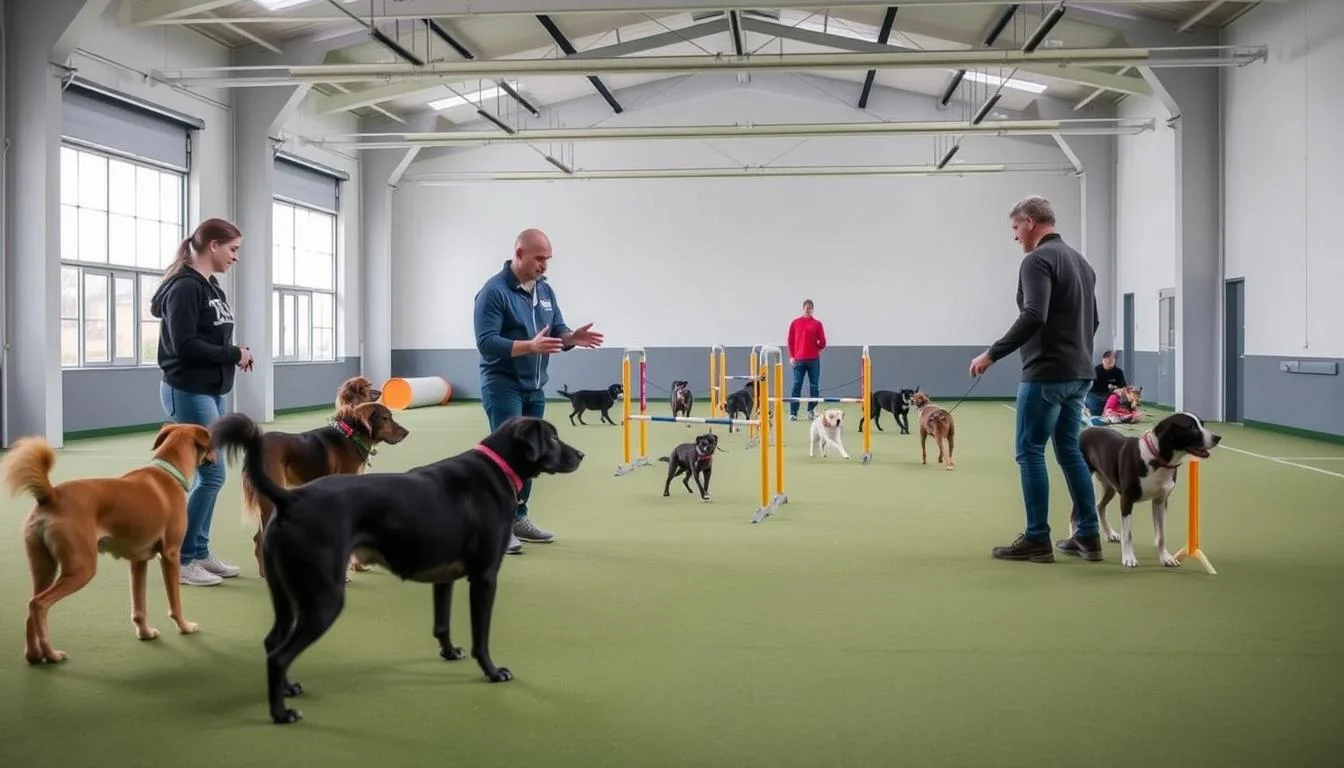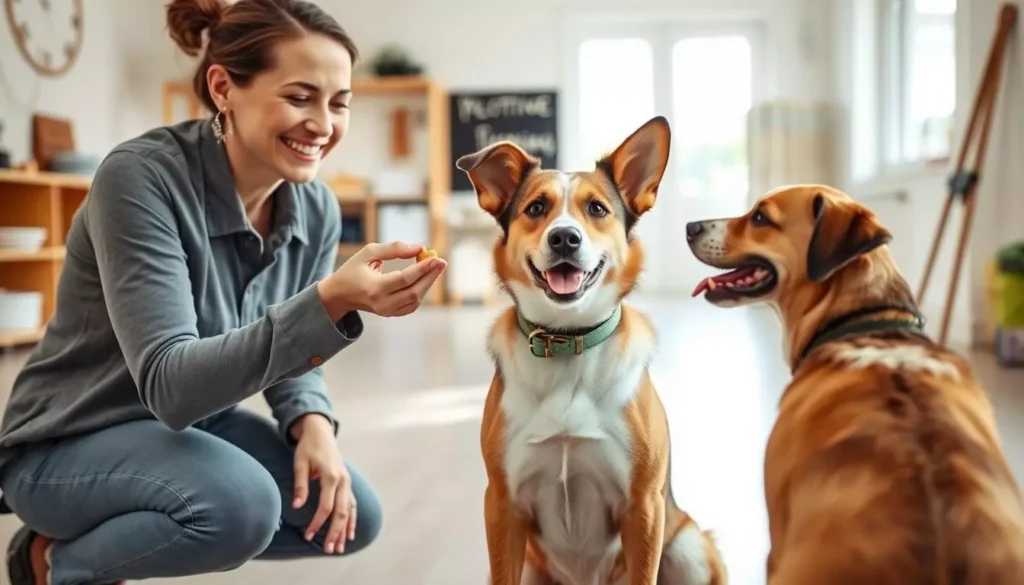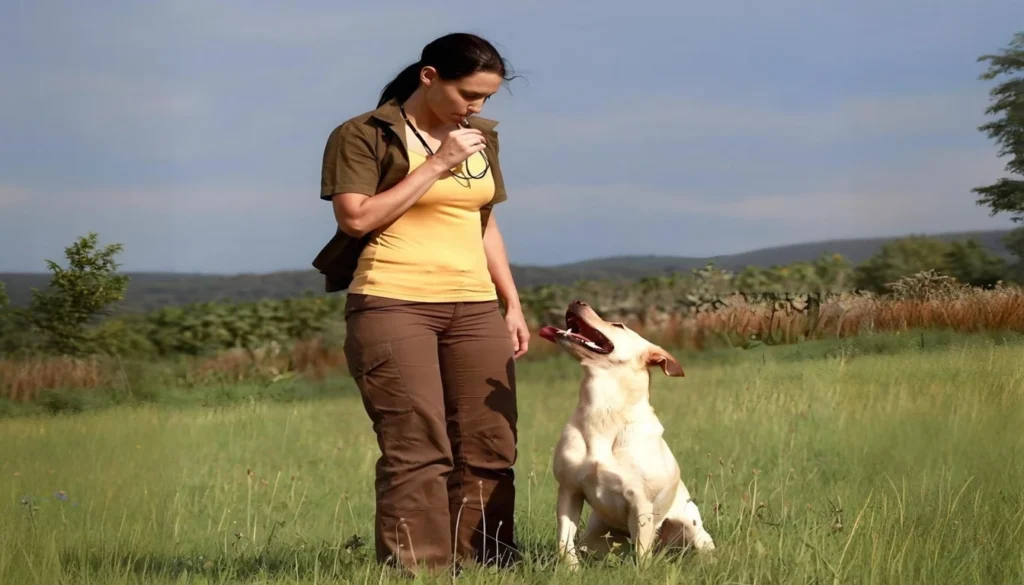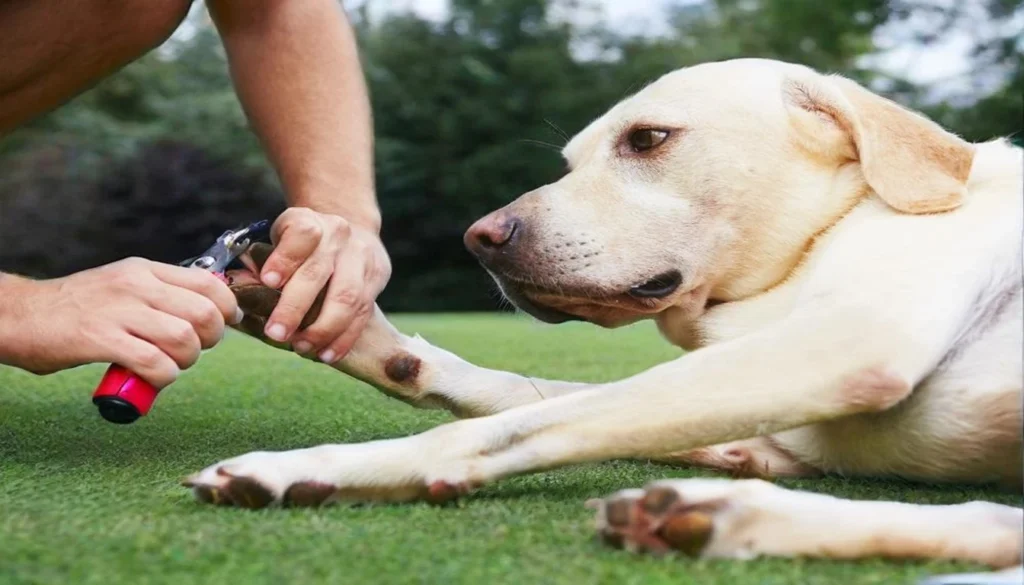I remember the first time my neighbor's Labrador lunged at my terrier. It was scary, and I worried about my dog's safety. This moment started my search for solutions, leading me to find effective dog training classes.
Aggression is common but not impossible to overcome. With the right training and behavior modification, dogs can learn to stay calm in stressful situations. Programs like K9Manners and K9 Academy offer customized plans and owner education, all under the guidance of a professional trainer.
Ignoring aggression can be dangerous. It can limit outings and make things worse over time. I'll guide you through the causes, how to assess, and the best training methods. My goal is to provide clear, practical advice on using positive reinforcement for lasting change.
Key Takeaways
- Targeted dog training classes for aggressive dogs can transform reactive behavior into reliable responses.
- A professional dog trainer offers individualized plans and measurable progress.
- Behavior modification for aggressive dogs emphasizes positive reinforcement and owner education.
- Early intervention prevents escalation and improves safety for people and pets.
- I will cover assessments, class formats, tools, and how to choose the right program in the United States.
Why aggression in dogs happens and when to seek help
Dog aggression is a sign, not a permanent trait. Knowing what triggers it helps owners act quickly. This can make treatment more effective.
Common causes of aggressive behavior
Fear and anxiety are big reasons. New faces, strange animals, and new places can make dogs defensive. Pain or health issues can also lead to sudden irritability or snapping.
Territorial instincts and poor socialization play a part too. Dogs not exposed to different experiences may get upset when things change. They might guard food, toys, or their favorite people.
How aggression escalates without intervention
Aggression rarely stays the same. Small signs like growls or stiff body language can turn into lunging and biting. If we don't change, it gets worse.
Ignoring the problem can lead to danger for everyone. It can also make the dog more isolated, making training harder. I always say, don't wait too long for help. It can lead to serious issues.
When to contact a professional dog trainer or certified dog behaviorist
Call a professional if you see growling, lunging, snapping, or any bite. Do it if aggression stops walks, visits, or daily life.
If trying to fix it yourself doesn't work, stop and get help. Early help in dog aggression classes or rehabilitation can stop problems before they start.
What I look for in a professional aggressive dog trainer
I want to see a trainer's skills, methods, and how they work with owners. When a dog shows serious threat cues, the right trainer can make a big difference. I look for experience with tough cases, a solid training plan, and a focus on owner education.
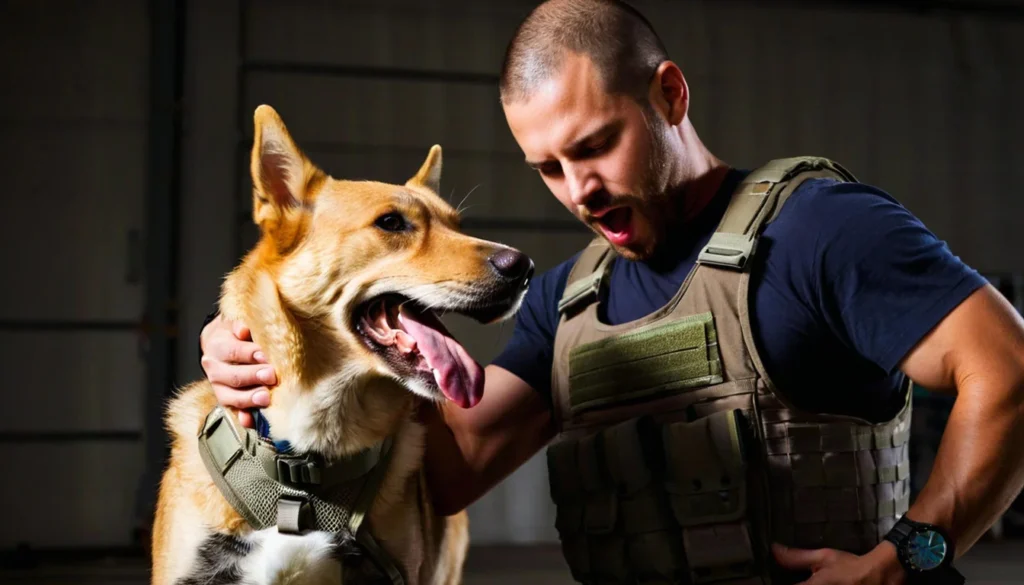
Credentials and experience
I prefer a trainer with proven success in rehabilitating aggressive dogs. Look for affiliations with respected programs and case histories from shelters. A certified dog behaviorist is a plus for severe aggression, showing they know a lot about dog behavior.
Training philosophy and techniques
I like trainers who use positive reinforcement as their base. They use desensitization and counter-conditioning with clear cues. I avoid trainers who promise the same thing for every dog. Instead, I look for plans that reward good behavior and track progress.
Owner education and follow-up
Teaching owners is key for me. Good programs teach body language, set rules, and practice at home. I prefer trainers who offer follow-up, set goals, and are available by phone to keep education going.
| What I Check | Why it Matters | Questions I Ask |
|---|---|---|
| Verified experience with aggressive cases | Shows practical success and risk awareness | Can you share case studies and references? |
| Certified dog behaviorist involvement | Ensures advanced assessment and treatment plans | Is a behaviorist part of the team for complex dogs? |
| Positive reinforcement, desensitization methods | Promotes lasting behavior change without fear | Which protocols do you use for counter-conditioning? |
| Owner education and follow-up schedule | Makes gains reliable and repeatable at home | Do you provide coaching, written goals, and check-ins? |
| Clear stance on tools and corrections | Aligns safety with ethical practice | Which management tools do you approve and why? |
Overview of dog training classes for aggressive dogs
I explain the main options for owners looking for help. Each type fits different dogs and lifestyles. I highlight the benefits to help you choose the right program.
There are four main types: small group sessions, one-on-one training, board-and-train stays, and hybrid packages. K9 Academy and K9Manners offer group training, board-and-train, and custom plans for severe issues. Group sessions help dogs practice in a controlled environment. One-on-one training allows for tailored techniques. Board-and-train provides daily work for quick progress.
Course length and format are common questions. Many programs last 8 weeks with weekly, one-hour lessons. Some limit class size to two people per dog for focus and safety. Intensive board-and-train sessions and weekend clinics are also available for faster change.
Schedules vary based on goals. Weekly group training builds steady progress. One-on-one training uses shorter sessions for skill building. Board-and-train offers daily routines at the facility, then follow-up lessons.
Aggressive behavior courses start with a behavior assessment. Trainers teach obedience skills like sit and stay. They also focus on desensitization and counter-conditioning around triggers. Owner education is included to teach safe management and daily practice.
Programs often provide tools and equipment guidance. Items include harnesses, leashes, muzzles, and treat pouches. Follow-up support is offered to reinforce gains and adjust plans as needed.
| Program Type | Best For | Typical Length | Core Features |
|---|---|---|---|
| Small group classes | Dogs needing controlled social exposure | 6–10 weekly sessions | Peer practice, trigger work, owner coaching |
| One-on-one dog training | Dogs with strong, specific triggers | Flexible (weekly or biweekly) | Customized plans, focused skill building, hands-on coaching |
| Board-and-train | Owners needing intensive, rapid change | 2–6 weeks typical | Daily training, consistent routines, handover sessions |
| Hybrid packages | Heterogeneous problems needing mixed methods | Custom timelines | Combination of group, one-on-one, and board-and-train elements |
Ask providers about class size limits, safety rules, and pre-class habituation to tools like muzzles. Clear expectations make participation safer and more productive for dogs and owners.
Behavior assessment: the first step to success
I start every program with a detailed behavior assessment for dogs. This step helps me create a safe and realistic plan. It also sets clear expectations for both owners and trainers.
What a thorough assessment covers
I first identify what triggers the dog's reactions. This includes people, other dogs, sounds, and places. I also figure out if the dog is scared, protective, guarding resources, in pain, or a mix of these.
I look at the dog's medical history and suggest vet visits if needed. I check the dog's basic obedience and how owners handle them. I also see how the dog reacts to common training tools.
How assessments guide customized training plans
An effective assessment helps me decide what training to focus on. This could be desensitization, obedience, managing the environment, or a medical referral. I set short-term goals and realistic timelines for changing the dog's behavior.
I recommend tools like muzzles, long leads, or e-collars when needed. I provide a detailed plan, including milestones, owner tasks, and safety measures. This helps keep training safe and effective.
| Assessment Component | What I Record | How It Shapes the Plan |
|---|---|---|
| Trigger Identification | Specific people, dogs, environments, and situations | Targets desensitization scenarios and avoidance strategies |
| Motivation Analysis | Fear, territoriality, resource guarding, pain indicators | Determines behavioral approach and need for vet referral |
| Medical Screening Recommendations | Suggested exams and pain checks | Prevents mislabeling medically driven aggression |
| Baseline Obedience | Response to recalls, sits, leash behavior | Sets training starting points and homework intensity |
| Owner Handling Habits | Management style, consistency, prior tools used | Shapes owner coaching and follow-up expectations |
| Deliverables | Written plan, weekly goals, safety protocols | Clear roadmap for behavior modification for aggressive dogs |
After the assessment, I talk to owners about what's next. If needed, I suggest a professional dog trainer. This helps owners choose the best path for their dog and family.
Positive reinforcement training and behavior modification for aggressive dogs
I teach owners simple steps to reduce threats and build trust. My approach focuses on reward-based methods and steady progress. This plan aims to change how dogs feel, not just what they do.
I start with easy-to-follow principles for daily use. Rewarding good behavior with treats or toys creates positive momentum. Using predictable cues and consistent schedules helps dogs learn without fear.
Principles of positive reinforcement
I avoid rewarding aggressive behavior by accident. It's important to handle dogs neutrally and at the right time. Training sessions are short and focus on calm behaviors like sitting and eye contact.
Using high-value rewards like Zuke’s or Stella & Chewy’s helps dogs learn faster. I pair rewards with praise and play to keep motivation high. Over time, rewards become less frequent to build lasting habits.
Desensitization and counter-conditioning protocols
I gradually expose dogs to triggers at a safe distance. This reduces stress and helps dogs form positive associations. Progress is slow and tracked to show owners the benefits.
Programs at K9Manners and K9 Academy show how pairing triggers with rewards changes behavior. Sessions are based on each dog’s needs and adjusted to avoid stress.
Examples of exercises used in classes
Functional obedience drills teach dogs to respond even with distractions. Drills include sitting while someone walks by and controlled greetings.
Distance-based exposure uses markers to measure space and rewards to close gaps slowly. Controlled approach/reward drills involve a stranger tossing a treat, then stepping closer if the dog stays calm.
Impulse-control games and mental tasks lower arousal. I use tug-for-control, puzzle feeders, and scent-work. Role-play scenarios and supervised interactions in daycare settings help dogs practice in real situations.
| Exercise | Goal | Typical Progression |
|---|---|---|
| Distance-based approach/reward | Reduce reactivity to strangers or dogs | Start 30+ feet, reward calm, move 5 feet closer over several sessions |
| Sit-stay with passerby | Build focus under mild distraction | Begin with one passerby at 50 feet, add movement and closer distance |
| Impulse-control games | Lower arousal and increase self-control | Short sessions of leave-it and trade games, then longer delays |
| Mental enrichment tasks | Reduce boredom-driven aggression | Introduce puzzle feeder, increase complexity weekly |
| Role-play supervised interactions | Practice real-world responses safely | Controlled volunteer approaches, scripted rewards, supervised escalation |
When and how trainers use management tools and corrections
I explain how safety and clear communication guide my choices when working with reactive dogs. I prefer tools that protect people and animals while supporting learning. I never use gear to intimidate. I focus on building trust and giving owners practical steps to manage risk.
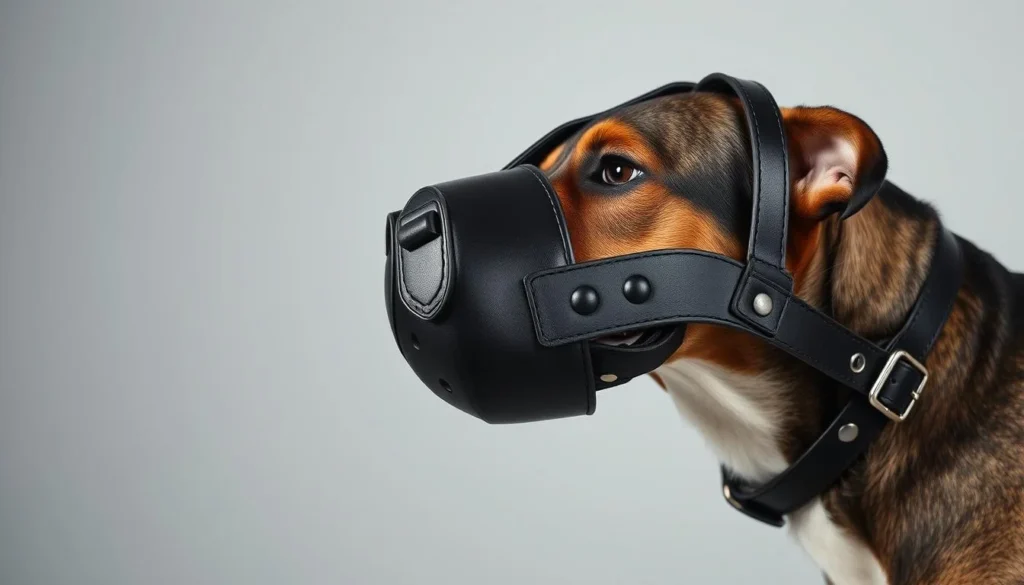
Safety-first management tools
I start with management devices that prevent bites and keep dogs calm during early training. A properly fitted basket muzzle for aggressive dogs allows safe handling and socialization without causing pain. Long training leads, such as 30-foot lines, let me practice distance control and recall while keeping the dog out of harm's way.
I often recommend slip leads and sturdy handling leashes for controlled entry and exits from vehicles or doorways. I teach owners how to avoid triggers and set up their home so the dog encounters fewer stressors while learning. Habituating a dog to a muzzle before class reduces stress and makes the tool effective when needed.
Use of collars and electronic devices
Some programs include calibrated tools to improve communication. Brands I encounter include E-Collar Technologies and Dogtra for e-collar use, and Herm Sprenger for prong collar options. When I introduce a prong collar or e-collar, I demonstrate fit, timing, and low-intensity signals so the device is a communication aid, not a punishment.
I offer alternatives when owners are uncomfortable with specific gear. I make sure any e-collar units or Herm Sprenger prong collar recommendations come with hands-on training and written guidance. Reputable trainers require particular equipment only when it reduces risk and speeds safe progress.
Ethical corrections vs. punishment
I distinguish ethical corrections from punitive actions that increase fear. Ethical corrections are brief, predictable, and proportionate. They aim to stop dangerous behavior while preserving the dog's willingness to learn.
My approach centers on positive reinforcement with carefully timed corrections reserved for safety-critical moments. I explain why a correction is used, how it is applied, and what the owner should expect. If a method raises fear, I stop it and pivot to a less intrusive option.
Below is a compact comparison of common tools, purpose, and ethical considerations I use to guide owners toward safe choices.
| Tool | Primary purpose | How I use it | Ethical notes |
|---|---|---|---|
| Basket muzzle | Prevent bites, allow safe handling | Fit gradually, pair with treats, use during vet visits or socialization | Must be habituated; not for punishment |
| 30-foot training lead | Distance control, recall practice | Teach recalls, manage threshold, layer distractions | Reduces risk while building skills |
| Slip lead / handling leash | Secure short-term control | Use for safe exits and brief handling; pair with calming cues | Use carefully to avoid tension-related stress |
| Prong collar (Herm Sprenger) | Increase handler control on strong or reactive dogs | Fit properly, use low-pressure correction, combine with reward-based work | Only when needed; avoid misuse that causes pain |
| E-collar (E-Collar Technologies, Dogtra) | Remote communication for distance cues | Start at lowest effective level, teach cue first, reward compliance | Require trainer instruction; aim for minimal intensity |
Group classes versus one-on-one dog training for aggressive dogs
I consider each dog and owner's needs before suggesting a training method. Some dogs do well in group settings with controlled practice. Others need private, intense training to stay safe and progress.
Benefits of small, structured group classes
For owners who want real-world socialization, I recommend small group classes. Dogs meet calm, trained friends in a controlled environment. This teaches them to handle people and other animals without getting overwhelmed.
Group classes are more affordable than private lessons. Owners learn to handle distractions and build skills in a real setting. Trainers create predictable challenges that mimic neighborhood situations.
When one-on-one training is a better fit
For severe aggression or complex medical cases, one-on-one training is best. Highly reactive dogs need the safety and customization of private sessions. I can adjust timing, distance, and interventions to fit each dog's needs.
Busy owners or those with legal or safety concerns benefit from personalized training. One-on-one sessions allow for quick problem-solving with small changes.
Hybrid approaches and board-and-train options
Hybrid programs are often recommended. They combine owner-involved sessions with focused blocks away from home. This mix allows owners to learn hands-on while trainers make rapid progress between sessions.
Board-and-train is ideal for busy families or those away from home. Programs like K9 Academy offer daily reinforcement before dogs return home for owner coaching.
I customize every plan for safety, progress, and owner ability to continue training at home. The right format balances exposure, customization, and real-life results.
What a successful 8-week aggressive dog training course looks like
I set clear goals before starting a program. This way, owners know what to expect. A good 8-week course includes assessments, practice, coaching, and clear goals. I check on progress every week and adjust the plan as needed.
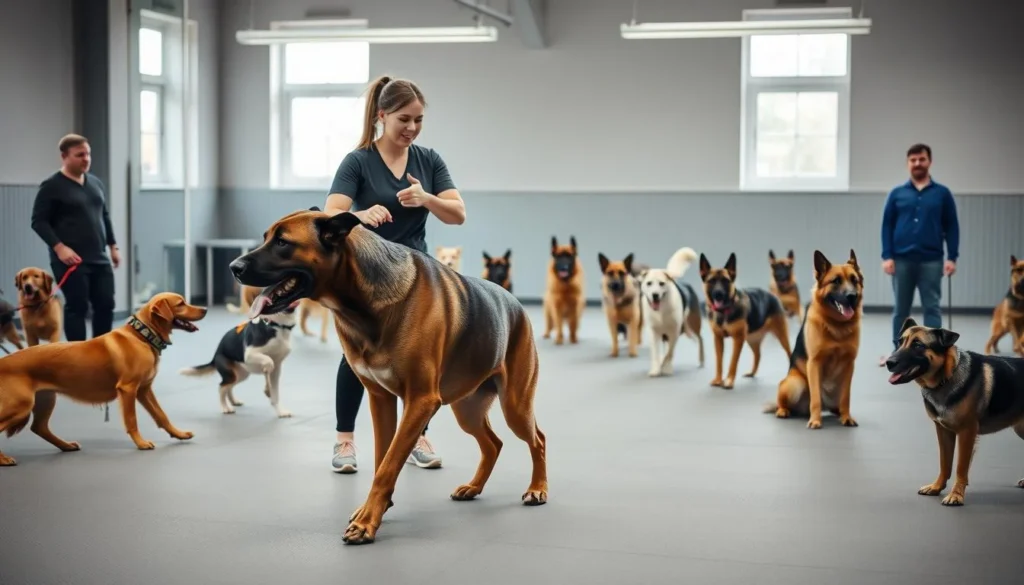
Our weekly plan follows common, humane practices. Week 1 focuses on intake, behavior assessment, and basic obedience. Weeks 2 and 3 build on obedience, introduce management, and teach using a basket muzzle and lead.
Weeks 4 and 5 tackle desensitization and counter-conditioning to triggers. Weeks 6 and 7 increase distractions and practice in real-world settings. Week 8 solidifies what's learned and prepares for long-term practice.
I recommend tools early so owners are ready. You'll need a basket muzzle, treats, a favorite toy, a long training lead, and a slip lead. Optional electronic collars from E-Collar Technologies or Dogtra are also suggested. Herm Sprenger prong collars are mentioned for controlled use.
Many programs provide or sell the tools needed. I explain how to use them safely and when they're needed. Safety and humane treatment are always the focus.
Some programs promise guaranteed results. But, I advise reading the fine print. Results depend on owner commitment, consistent effort, and using the right equipment.
Be wary of promises for quick fixes. Training an aggressive dog is complex, depending on the dog's history and environment. I set clear graduation criteria and explain what ongoing work will involve.
Owner’s role in rehabilitation and at-home practice
I help owners create a plan to turn class work into daily habits. My goal is to give you practical steps for home use. This helps support progress and avoid setbacks. The owner's role in dog training is active, consistent, and attentive.
I suggest short, daily training sessions that mix obedience, impulse control, and fun. A tired dog is less aggressive. So, I include consistent exercise and mental activities in the schedule.
Structured feeding, enrichment toys, and scheduled walks help manage triggers and stress. These elements are key for at-home practice with aggressive dogs. They make progress easy to track.
Reading and responding to body language
I teach owners to spot early stress signals to prevent escalation. It's about noticing small changes in posture, ear position, and eye contact.
When you see tension, I show you how to lower arousal and redirect attention. Trainers from K9 Academy and K9Manners emphasize the importance of owner education. They help prevent incidents by understanding states of mind and motivations.
Consistency, patience, and realistic expectations
Consistency in training is key. I ask owners to stick to protocols and avoid old habits. Progress is often slow, so patience is crucial.
I encourage celebrating small victories and setting realistic goals. My programs have small class sizes and require daily practice at home. This matches the pace of professional sessions.
| Focus Area | Daily Action | Why it Helps |
|---|---|---|
| Exercise & Mental Work | Two 20-minute sessions: walk + puzzle toy | Reduces excess energy and boredom that fuel reactivity |
| Short Training Sessions | 5–10 minutes, 3–4 times daily | Builds skills without overwhelming the dog |
| Trigger Management | Structured routes, barrier use, timed exposures | Limits surprise encounters and controls learning pace |
| Body Language Practice | Daily 5-minute observation and note-taking | Improves early detection and faster intervention |
| Trainer Coordination | Weekly check-ins and video reviews | Keeps owner role in dog training aligned with professional plans |
| Consistency Tools | Use of cues, timers, and a written routine | Supports consistency in training and prevents backsliding |
How to choose the right program in the United States
I help owners find the best dog training programs. It's important to pick one that fits your dog's past and your learning style. I look for clear assessments, education for owners, and realistic goals, not quick fixes.
First, I ask key questions before booking. These questions help understand the trainer's methods, experience, and what you can expect.
Questions to ask before you book
- What are your credentials and experience with aggressive dogs?
- Do you perform a behavior assessment and share written findings?
- What methods do you use: positive reinforcement, desensitization, counter-conditioning?
- Which tools do you require and why will they be used?
- What is the class format, typical class size, and progression plan?
- What owner education and follow-up support do you provide after classes end?
I suggest taking notes during these conversations. This way, you can compare answers from different programs and spot any inconsistencies.
Red flags to avoid
- Promises of instant fixes or guaranteed results without contingencies.
- Refusal to explain techniques or the purpose of equipment.
- Exclusive reliance on punitive methods with no behavior modification plan.
- No owner education or plan for follow-up sessions.
- Unwillingness to perform an assessment or to coordinate with a veterinarian on medical causes.
Pay attention to how a trainer explains their methods. Clear and patient answers show they value your involvement.
Finding local options and free evaluations
Look for certified behaviorists and professional trainers with proven success. I use local referrals, rescue groups, and vetted reviews to find the best options.
Search for programs that offer a free evaluation or introductory call. A free evaluation dog training phone consult lets you ask immediate questions. K9 Academy and several regional trainers provide initial phone assessments without charge.
| What to Verify | Why It Matters | Red Flag |
|---|---|---|
| Behavior assessment | Creates a tailored plan and identifies triggers | No assessment offered |
| Trainer credentials | Shows experience with aggressive cases | Vague or unverifiable claims |
| Training methods | Ensures humane, evidence-based techniques | Reliance on punishment only |
| Owner education & follow-up | Improves long-term success at home | Minimal or no follow-up plan |
| Free evaluation dog training | Low-risk way to assess fit before paying | No opportunity to meet or ask questions first |
| Logistics (age, equipment, schedule) | Makes sure your dog can attend and benefit | Unclear or inflexible requirements |
When choosing, balance credentials with how comfortable you feel with the trainer. Use the questions to ask dog trainer checklist, watch for red flags dog trainers, and schedule a free evaluation dog training call when possible. This approach helps me find programs that fit each dog and owner in the United States.
Conclusion
I think it's possible to change aggressive behavior in dogs. First, we need to understand what's causing it. A professional dog trainer can then create a plan that includes obedience training and ways to calm the dog.
This approach helps reduce what makes the dog upset and builds trust again. Positive reinforcement and structured programs are key. They can be an 8-week course, board-and-train, or one-on-one sessions.
It's important to use management tools and corrections in a responsible way. Daily practice at home helps make lessons stick. This keeps everyone safe.
Before starting, ask lots of questions and check the trainer's credentials. Look for free evaluations if you can. Being realistic, patient, and working together can change a dog's behavior.
With the right team and plan, dog training can make your life together safer and happier.

